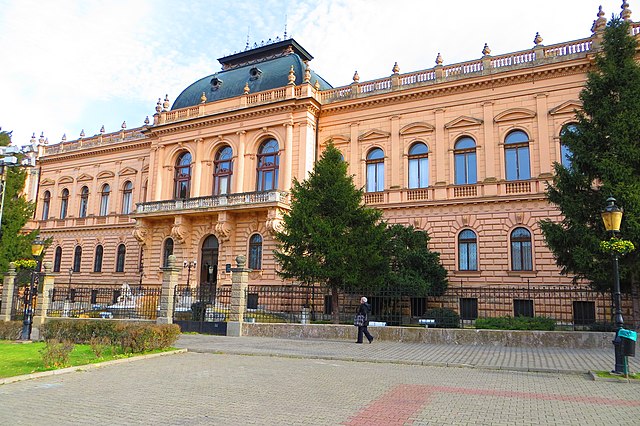Top Qs
Timeline
Chat
Perspective
Patriarchate of Karlovci
Former patriarchate of the Eastern Orthodox Church From Wikipedia, the free encyclopedia
Remove ads
The Patriarchate of Karlovci (Serbian: Карловачка патријаршија, romanized: Karlovačka patrijaršija) or Serbian Patriarchate of Sremski Karlovci (Serbian: Српска патријаршија у Сремским Карловцима, romanized: Srpska patrijaršija u Sremskim Karlovcima), was a patriarchate of the Eastern Orthodox Church that existed between 1848 and 1920. It was formed when the Metropolitanate of Karlovci was elevated to the rank of patriarchate.[1][2] The Patriarchate of Karlovci nominally existed until 1920, when along with several other Eastern Orthodox jurisdictions in the defunct Austro-Hungarian Empire, as well as the Metropolitanate of Cetinje, it was merged with the Metropolitanate of Belgrade to form the united Serbian Orthodox Church.[3][4] The seat of the Patriarchate was in Karlovci (today Sremski Karlovci, Serbia).



Remove ads
History
Summarize
Perspective
At the May Assembly in Sremski Karlovci in 1848, prior to the Serb uprising of 1848–49, the Serbs of the Habsburg monarchy proclaimed the creation of the Serbian Vojvodina, a Serb autonomous region within the Monarchy. The metropolitan of Karlovci, Josif Rajačić, was also proclaimed "Serbian Patriarch", thus the Metropolitanate of Karlovci became a Patriarchate.[5] The title of "Serbian Patriarch" given to Rajačić was confirmed by the Emperor Franz Joseph I the same year.[6]
This confirmation of Rajačić as the Serbian Patriarch, and Stevan Šupljikac as Vojvoda, was a political move made by Emperor Franz Joseph I. He was confronted with revolution in his country and had difficulties subduing the Hungarians under Kossuth. Šupljikac and his Croatian counterpart, Josip Jelačić supported the Emperor against the Hungarians.[6]
The position of Serbian Orthodox Church and Serbs in Austria and Hungary was regulated in reforms brought about first by Empress Maria Theresa and later by Emperor Joseph II. The Serbian Church-Public Council of 1769 regulated the Serbs and their Church status in a special paper named "Regulament" and, later, in the "Declaratory Rescript of the Illyrian Nation" issued by Maria Theresa in 1779. These acts regulated the life of the Metropolitanate of Karlovci until 1868. Emperor Franz Joseph I published a special edict regulating Serbian Orthodox Church affairs and his edict was in force until the unification of Serbian Churches in 1920.[7]
The establishment of the Patriarchate in Karlovci was seen as restoration of Serbian unity in Austria and Hungary and the patriarch was considered the ranking personage among the Serbs.[8] Some authors claimed that actually the Habsburg dynasty in Austria founded the patriarchate of Karlovci because only a Sovereign could institute and recognize the rank of the Patriarch.[9]
In 1865, the Eastern Orthodox Romanians that were under jurisdiction of the Patriarchate of Karlovci were separated and transferred to the jurisdiction of newly created Romanian Metropolitanate of Sibiu under Andrei Șaguna. Process was accomplished by mutual agreement that included the transfer of the Eparchy of Arad and eastern parts of Eparchy of Temišvar and Eparchy of Vršac.
In 1873, Bishopric of Chernivtsi in Bukovina, that was since 1783 under the spiritual jurisdiction of Karlovci, was elevated to the rank of Archbishopric when new Metropolitanate of Bukovinian and Dalmatia was created for Cisleithanian eparchies. New Archbishop of Chernivtsi gained jurisdiction over Serbian eparchies of Dalmatia and Kotor, that also were (until then) under spiritual jurisdiction of Karlovci.[1]
Emperor Franz Joseph I exercised full control over the Patriarchate. In 1890, contrary to the Serb Church Congress ruling but according to the Orthodox tradition of royal prerogatives, he promoted Georgije Branković to the patriarchal throne. That way the emperor discredited the Church hierarchy in the eyes of laity and encouraged rise of the anti-clerical Serb People's Radical Party in Austria-Hungary.[10][11]
The last patriarch, Lukijan Bogdanović, was murdered in 1913. After his death, the patriarchal throne remained vacant for the last seven years of its existence, with following bishops serving as locum tenens: Miron (Nikolić) of Pakrac (1913 and 1914–1919), Mihailo (Grujić) of Gornji Karlovac (1913–1914) and Georgije (Letić) of Temišvar (1919–1920; coadjutor 1918–1919).
Following the dissolution of Austria-Hungary in the autumn of 1918, the Patriarchate of Karlovci was in 1920 merged into the newly united Serbian Orthodox Church under one Serbian patriarch residing in Belgrade, with the title of Archbishop of Peć, Metropolitan of Belgrade and Karlovci and Serbian Patriarch.[3]
During World War II, the Independent State of Croatia (NDH), a puppet state of Nazi Germany and Fascist Italy led by the Fascist Ustaše movement, was established in parts of occupied Yugoslavia. Due to the German pressure over growing anarchy in the country, caused by the Genocide of Serbs with the ultimate goal of creating an ethnically pure Greater Croatia,[12] the Ustaše created a unrecognized[13] sect named the Croatian Orthodox Church (1942–1945) in order to annihilate and Croatise the remaining Serb minority. It was meant to destroy religious, cultural and national ties between Serbs in Serbia and Serbs in the NDH, as the Ustaše at time could not achieve their goal of exterminating the whole Serb population of Croatia.[14] After several robberies and bombings of Serbian Orthodox properties, and massacres and war crimes against Serbian Orthodox clergy,[15] the Croatian Orthodox Church attempted to self-proclaim itself as the heir of the Patriarchate of Karlovci, but its Archbishop Germogen Maximov was enthroned in Zagreb.[16]
Remove ads
Eparchies
The Patriarchate included the following eparchies:
Remove ads
Patriarchs, 1848–1920
Timeline

See also
References
Literature
External links
Wikiwand - on
Seamless Wikipedia browsing. On steroids.
Remove ads






